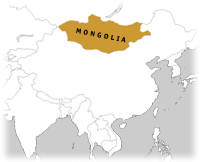 |
|
|
 In June 1997 more than 100 people met for an Internet conference
in Mongolia... In June 1997 more than 100 people met for an Internet conference
in Mongolia...
Why Mongolia? Until late 1994 the country had no Internet access. By June 1997 local technicians were able to set up a temporary Internet center for Net-dependent conference attendees, enable presenters to demonstrate remote Web sites live from the conference floor, and of course share the trials of providing Internet access for a developing country with anyone interested. How they got to that stage is of course a different story. When the Soviet Union collapsed in 1991, so too did many of the subsidies and much of the trade that had been underpinning the Mongolian economy. As a result, the country made the hard decision to open up and move to a market, rather than a planned, economy. However, with limited funds and many priority projects, including provision of basic services such as electricity for remote areas, no one underestimated the difficulty of the task. One of the first of many organizations to go down the privatization route was Datacom, a state-owned enterprise involved in data networking. Datacom's enterprising director general Dr. Dangaasuren Enkhbat had heard through magazines about the Internet and decided to bring it to the country. Like other ambitious projects, however, lack of funds was the major stumbling block. Fortuitously, at around that time in 1994, the Canadian-based International Development Research Centre (IDRC) was funding its Pan Asia Networking (PAN) program. The PAN program aims to support development of communications infrastructure in the less developed countries of Asia. The IDRC itself is a public corporation created by the parliament of Canada to help researchers and communities in the developing world find solutions to social, economic, and environmental problems. With similar goals, PAN and Datacom came to an agreement whereby Datacom would be offered technical and financial assistance to get Enkhbat's project off the ground. For PAN, it also was a chance to push forward with its aim of creating a series of Internet sites that could be linked to form a regional network that would provide information for researchers and development workers in Asia. Thus, Mongolia was the first site chosen for the whole PAN program. In addition, the project was used as a pilot to assess how assistance might be offered to other developing countries in the region. Mongolia was appropriate for a number of reasons. Having only recently made the transition to a market economy, it was in desperate need of information from the rest of the world and ready to reforge links with neighboring countries. Datacom had a team that could undertake the technical requirements needed to become an Internet provider. And as a remote country without Internet access, Mongolia offered a chance to study the technical challenges that would be applicable to other countries in the region. Paul Wilson, a consultant at Australia-based networking company Pegasus Networks, was involved in the project as a technical adviser in the preliminary stages. He was impressed by Datacom's technical capabilities at the time and, as a result, its likelihood of success. As he notes, "They were clearly out there and ready." However, Wilson also points out that the conditions Datacom had to work under were poor, even though similar to many other developing countries in Asia. Problems included unreliable telephone lines, telephone exchanges based on nonstandard and outdated Russian technology, erratic power, and few computers. But even at that early stage, Datacom had built up its own messaging system--adapted from Russian software--which was robust enough to cope with the conditions. According to Wilson, the system, called PC-Mail, was based on a file transfer model and seemed reliable. In addition, it allowed for messaging in Mongolia's Cyrillic-based script. "It was quite an achievement that the PC-Mail system was all local development. They also had a clear awareness that they could adapt it to UUCP protocols," he says, referring to the Unix-based program that can be used for transferring files on the Internet. This occurred in late 1994, when Datacom installed a dial-up gateway system based on UUCP protocols that allowed for connection of its domestic system to the Internet. The system was compatible with Internet e-mail and newsgroups, and initially these were transferred twice weekly by connecting to the Institute of Global Communications (IGC) in the United States. The network was officially called MagicNet, the magic part standing for Mongolia Access to Global Information and Communications. The domain name magicnet.mn has now been registered with Internic. As the system gained new users, the dial-up frequency got increased, first to a daily connection and then to twice daily in April 1995. However, Datacom's goal was to have a permanent Internet connection. After looking at various leased-line options with different PTTs in the region, the most economical and feasible connection turned out to be via satellite. A meeting with Sprint concluded in an agreement to cooperate on a 128k leased-line satellite link via PanAmSat 2. Funding for the link came from a government loan and the U.S. National Science Foundation (NSF), which agreed to pay the leasing costs if Datacom gave Mongolia's educational institutions free Internet access during 1996/97. The government loan is an interesting funding scheme in itself. Known locally as the butter fund, it was established thanks to a U.S. Agriculture Department donation of surplus butter. The Mongolian government sold the butter on the domestic market, thereby creating a fund for loans and grants that could be used for special projects. Satellite communications equipment from Comstream was installed in late 1995--along with a Sun Netra server and Sun workstation to host Web, FTP, and Gopher servers--culminating in the opening ceremony for the country's first permanent Internet connection in January and a Mongolian Web site in March 1996. Even with its first Internet node in place, Datacom was still keen to push further with the technology. Enkhbat commented at that time that the challenge of creating a local infrastructure to spread the benefits of the Internet to the wider community was a harder task than actually getting linked to the Internet. One of the biggest problems is the poor quality of the telephone lines outside Ulan Bator, the capital. However, the Asian Development Bank recently injected funds into the local PTT. One of the first improvements in the public network will come to Mongolia's other two major centers, Erdenet and Darkhan, which are being linked via a 34-Mbps digital microwave system. Datacom itself is involved in installation of a private VSAT network, which is already being deployed in 20 provincial areas. The project is being financed by a Mongolian gas and oil corporation, but there is also agreement for public Internet e-mail access that will be managed by Datacom. In this way, the company hopes to improve its service to remote areas. Mongolia's education sector also is receiving help from a number of places. The NSF, in addition to helping with satellite leasing costs, aims to improve connections to universities through grants for radio modems. Six Mongolian institutes will benefit from the funding, which will enable them to set up their own Internet host. In a similar arrangement, the International Science Foundation--formed nearly four years ago by Hungarian-born financier George Soros to support scientific projects in countries aligned with the former Soviet Union--gave grants to another six organizations for radio modem links to Datacom's network. All of the above happened in approximately two years, which no matter what part of the world you're from represents a dramatic change. The Datacom experience also has been passed on informally to other organizations, in other parts of Asia, that are in various stages of creating their own PAN nodes. Projects have been started in Bangladesh, Cambodia, India, Laos, Nepal, the Philippines, Sri Lanka, and Vietnam. In an attempt to consolidate all that has happened, in both Mongolia and the other countries, PAN decided to hold its first all-partners conference--in Mongolia, of course. Participants from throughout Asia had interesting experiences to relate, but their Mongolian hosts were able to show their achievements firsthand to a welcoming audience. In the short time since achieving that first connection, enterprising
Mongolians have created daily e-mail newsletters, travel agency
sites, on-line training areas for journalists, a business development
site, a geological site, a forthcoming government of Mongolia
Web site, and many more. Links to regional areas and within the
city are being upgraded by means of low-cost wireless technology,
and a public Internet center in the country's main library has
been built. It is expected to provide local access, training,
demonstrations, and a business area. So when the question Why
a conference in Mongolia? next crops up, now you know the answer. |

